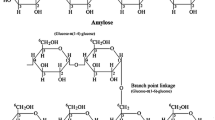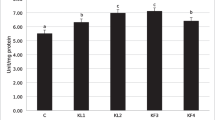Abstract
Pink discolouration is a problem faced in the squid processing industry, and some treatments have been implemented to tackle such a problem. The study aimed to elucidate the impact of NaCl in combination with oxidising agents on the quality changes of squid during frozen storage. The effects of treatment of pink squid using 3% (w/v) NaCl solution containing oxidising agents (0.05–0.5% (w/v) H2O2 or 0–10 ppm NaOCl) on colour and chemical and physical changes of squid during frozen storage were investigated. The lowest decreases in a*, b* values, ∆E* and ∆C* of squid were obtained with the treatment using 3% NaCl solution containing 0.5% H2O2. Nevertheless, NaOCl (0–10 ppm) had no impact on a* and b* values. During frozen storage at −18 °C for 10 weeks, fresh squid, pink squid samples without and with treatments with 3% NaCl solution containing 0.5% H2O2 had no changes in a* and b* values during frozen storage. Nevertheless, thiobarbituric acid reactive substances value, disulphide bond content, thaw drip and shear force were more pronounced in treated pink squid, compared with pink squid without treatment (control) and fresh squid, respectively, during the extended storage (p < 0.05). Higher denaturation and aggregation of muscle proteins during frozen storage were observed in treated pink squid than that without treatment and fresh squid, respectively. Therefore, pink squid treated with oxidising agent was prone to protein aggregation and denaturation during the extended frozen storage, though it could lower the pink colour. Therefore, fresh squid without treatment using oxidising agent is recommended for production of frozen squid with negligible loss in quality during extended storage.



Similar content being viewed by others
References
Aewsiri, T., Benjakul, S., & Visessanguan, W. (2009). Functional properties of gelatin from cuttlefish (Seapia pharaonis) skin as affected by bleaching using hydrogen peroxide. Food Chemistry, 115, 243–249.
Benjakul, S., Seymour, T. A., Morrissey, M. T., & An, H. (1997). Physicochemical changes in Pacific whiting muscle proteins during iced storage. Journal of Food Science, 62, 729–733.
Benjakul, S., Visessanguan, W., Thongkaew, C., & Tanaka, M. (2003). Comparative study on physicochemical changes of muscle proteins from some tropical fish during frozen storage. Food Research International, 36, 787–795.
Buege, J. A., & Aust, S. D. (1978). Microsomal lipid peroxidation. Methods in Enzymology, 52, 32–34.
Chan, W. K. M., Faustman, C., & Decker, E. A. (1997). Oxymyoglobin oxidation as affected by oxidation products of phosphatidylcholine liposomes. Journal of Food Science, 62, 709–712.
Cosansu, S., & Ayhan, K. (2010). Effects of lactic and acetic acid on survival of Salmonella enteritidis during refrigerated and frozen storage of chicken meats. Food and Bioprocess Technology. doi:10.1007/s11947-009-0320-x.
Dawson, P. L., Sheldon, B. W., & Miles, J. J. (1991). Effect of aseptic processing on the texture of chicken meat. Poultry Science, 70, 2359–2367.
Department of Fisheries. (2004). Manual of sanitation in production of fishery products. Thailand: The Agricultural Co-operative Federation of Thailand, Ltd.
Doorn, J. A., & Petersen, D. R. (2002). Covalent modification of amino acid nucleophiles by the lipid peroxidation products 4-hydroxy-2-nonenal and 4-oxo-2-nonenal. Chemical Research in Toxicology, 15, 1445–1450.
Ellman, G. L. (1959). Tissue sulfhydryl groups. Archives of Biochemistry and Biophysics, 82, 70–77.
FAO. (2003). FAO globefish cephalopods commodity update. Rome: FAO.
FAO. (2008). FAO globefish cephalopods commodity update. Rome: FAO.
Hayakawa, S., & Nakai, S. (1985). Contribution of hydrophobicity, net charge and sulfhydryl groups to thermal properties of ovalbumin. Canadian Institute of Science and Technology Journal, 18, 290–295.
Huang, Y., Kouadio, K., & Gates, K. W. (1993). Effect of packaging on chemical changes and quality of refrigerated spot (Leiostomus xanthurus). Journal of Aquatic Food Product Technology, 1(2), 111–127.
Karel, M., Schaich, K., & Roy, R. B. (1975). Interaction of peroxidizing methyl linoleate with some proteins and amino acids. Journal of Agricultural and Food Chemistry, 23, 159–163.
Ke, P. J., Burns, B. G., & Woyewoda, A. D. (1984). Recommended procedures and guidelines for quality evaluation of Atlantic short-fin squid (Illex illecebrosus). International Journal of Food Science & Technology, 17, 276–281.
Khayat, A., & Schwall, D. (1983). Lipid oxidation in seafood. Food Technology, 37(7), 130–140.
Kolodziejska, I., Niecikowska, C., & Sikorski, Z. E. (1994). Dimethylamine and formaldehyde in cooked squid (Illex argentinus) muscle extract and mantle. Food Chemistry, 50, 281–283.
Lakshmanan, P. T., Varme PR, G., & Iyer TS, G. (1993). Quality of commercially frozen cephalopod products from India. Food Control, 4, 159–164.
Lapa-Guimaraes, J., Azevedo, A., da Silva, M., Eduardo de Felicio, P., & Guzman, E. C. (2002). Sensory, color and phychrotrophic bacterial analyses of squid (Loligo plei) during storage in ice. Lebensmittel-Wissenchaft und Technologie, 35, 21–29.
Lapa-Guimaraes, J., de Felicio, P. E., & Guzman, E. S. C. (2005). Chemical and microbial analyses of squid muscle (Loligo plei) during storage in ice. Food Chemistry, 91, 477–483.
Maity, T., Raju, P. S., & Bawa, A. S. (2009). Effect of freezing on textural kinetics in snacks during frying. Food and Bioprocess Technology. doi:10.1007/s11947-009-0236-5.
Mignino, L. A., Crupkin, M., & Paredi, M. E. (2008). Surface hydrophobicity and functional properties of myofibrillar proteins of mantle from frozen-stored squid (Illex argentinus) caught either jigging machine and trawling. LWT Food Science and Technology, 41, 678–685.
Ota, F., & Tanaka, T. (1978). Some properties of the lipid portion in the frozen fish muscle fluid. Bulletin of the Japanese Society of Scientific Fisheries, 44, 59–62.
Paredi, M. E., Roldan, H. A., & Crupkin, M. (2006). Changes in myofibrillar proteins and lipids of squid (Illex argentinus) during frozen storage. Food Chemistry, 30, 604–621.
Perkins, W. S. (1996). Advances made in bleaching practice. Alexander Technique International, 4, 92–94.
Phatcharat, S., Benjakul, S., & Visessanguan, W. (2006). Effect of washing with oxidising agents on the gel-forming ability and physicochemical properties of surimi produced from bigeye snapper (Priacanthus tayenus). Food Chemistry, 98, 431–439.
Robinson, H. W., & Hogden, C. G. (1940). The biuret reaction in the determination of serum proteins: I. A study of the conditions necessary for the production of a stable color which bears a quantitative relationship to the protein concentration. Journal of the Biological Chemistry, 135, 707–725.
Rossoni EM, M., & Gaylarde, C. C. (2000). Comparison of sodium hypochlorite and peracetic acid as sanitizing agents for stainless steel food processing surfaces using epifluorescence microscopy. International Journal of Food Microbiology, 61, 81–85.
Ruiz-Capillas, C., Moral, A., Morales, J., & Montero, P. (2002). The effect of frozen storage on the functional properties of the muscle valador (Illex coindetti). Food Chemistry, 78, 148–156.
Santos, E. E. M., & Regenstein, J. M. (1990). Effects of vacuum packaging, glazing and erythorbic acid on the shelf-life of frozen white hake and mackerel. Journal of Food Science, 55, 64–70.
Thannhauser, T. W., Konisshi, Y., & Scheraga, H. A. (1987). Analysis for disulphide bonds in peptides and proteins. Method in Enzymology, 143, 115–118.
Thanonkaew, A., Benjakul, S., & Visessangvan, W. (2006). Chemical composition and thermal property of cuttlefish (Sepia pharaonis) muscle. Journal of Food Composition and Analysis, 19, 127–133.
Thanonkaew, A., Benjakul, S., Visessangvan, W., & Decker, E. A. (2008). The effect of antioxidants on the quality changes of cuttlefish (Sepia pharaonis) muscle during frozen storage. LWT Food Science and Technology, 41, 161–169.
Ueng, Y., & Chow, C. (1998). Textural and histological changes of different squid mantle muscle during frozen storage. Journal of Agricultural and Food Chemistry, 46, 4728–4733.
United States Environment Protection Agency (US EPA). (1989). Drinking water criteria document for chlorine, hypochlorous acid and hypochlorite ion. Cincinnati: Environmental Criteria and Assessment Office.
United States Environment Protection Agency (US EPA). (1994). Chemical summary for chlorine. Cincinnati: Office of Pollution Prevention and Toxics.
United States Food and Drug Administration (US FDA) (2004) Code of Federal Regulation.Title 21, Food and drugs. Chapter I. Food and Drug Administration. Part 173-secondary direct food additive permitted in food for human consumption. Section 173.315 Chemicals used in washing or to assist in the peeling of fruits and vegetables.
Xiong, Y. L. (2000). Protein oxidation and implication for muscle food quality. In Antioxidants in muscle food (pp. 85–111). New York: Wiley.
Acknowledgements
The author would like to express their sincere thanks to Prince of Songkhla University for the financial support.
Author information
Authors and Affiliations
Corresponding author
Rights and permissions
About this article
Cite this article
Benjakul, S., Sungsri-in, R. & Kijroongrojana, K. Effect of Treating of Squid with Sodium Chloride in Combination with Oxidising Agent on Bleaching, Physical and Chemical Changes During Frozen Storage. Food Bioprocess Technol 5, 2077–2084 (2012). https://doi.org/10.1007/s11947-010-0460-z
Received:
Accepted:
Published:
Issue Date:
DOI: https://doi.org/10.1007/s11947-010-0460-z




